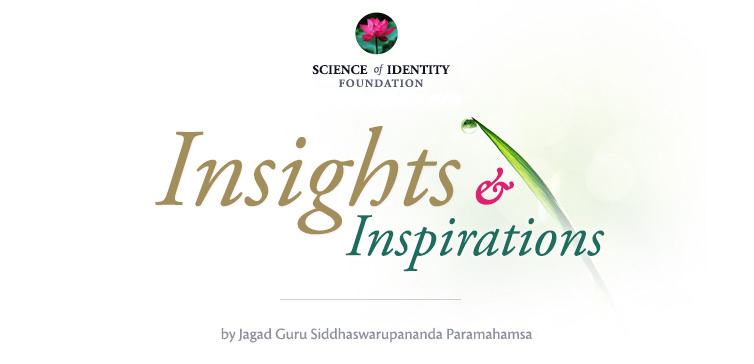Another World View
Jagad Guru: That I don't need to conclude that because there is no material self, therefore there is no self. I can conclude instead, I can have my conclusion based upon number one, the reality that I know I exist. I know I exist and this is the fundamental reality that I can never give up. I know I exist, my self-awareness. Therefore, instead of giving up my self-awareness, I give up the materialist world view which cannot explain my self-awareness.
Any theory, any world view, which does not take into account that which is most real, cannot be accepted. We don't want to throw away reality, that is, the awareness of our own existence. We're going to throw away reality in order to protect or hold onto this world view, this materialist world view which holds that there is only one element - matter? This is basically what we would be doing. You see, we have a choice. We can throw away the materialist world view. We can throw that away. Or we can throw away our existence. (laughter) That's our choice.
So, no-self theorists like Francis Crick and others, they… their conclusion is, well, since there is no material self, there is no self. There is… we don't exist, there is no one. We've not found anyone. Therefore there is no one. We say, no, there is another choice here. We don't need to throw away our awareness of our own existence. Rather we can throw away the idea that if we exist, we have to be made of matter.
Why can't we be made of an element other than matter? They say, well, there's only one element, matter. And we say, well, but we aren't made of matter. There's obviously no material self anywhere in the body. And the body as a whole is not the material self - there is no material self. So, how can we be made of matter? They say, well, you can't be, you're not. Okay? So, then I… so then I say, well, if I'm not made of matter, I must accept I'm made of another element. They go, no, no, no. Why? Because, because it means that we would have to give up the conclusion that there's only one energy – matter - and we'd have to accept the religious or almost religious, vitalist view that there's another fundamental element; that you can exist and yet you're not made of matter! If you exist and you're not made of matter, what does that do? What does that, what does that say, anyone? It says that there are two elements! That matter is not the only fundamental element. I mean, if I can exist and I'm not made of matter, that means that some other energy exists, some other element exists other than matter, right?
Audience: Uhmmhmm. Yes.
Jagad Guru: So therefore, we come to the conclusion that I am made of an element other than matter. I am made of a completely distinct element. And this is not a new view. Yet one of the… one of the most respected neurosurgeons, Dr. Wilder Penfield, concluded at the end of his illustrious career as a neurosurgeon, working on conscious patients who had epilepsy, he concluded in his book, “The Mystery of the Mind” quote:
“I am forced to choose the proposition that our being is to be explained on the basis of two fundamental elements. This, to my mind, offers the greatest likelihood of leading us to the final understanding toward which so many stalwart scientists strive.”
Unquote. So, as I said, this is not a new view. This is the basic understanding of all traditional religious thought and philosophers such as Socrates and so on. That in fact, there’s two fundamental elements. What names we give this other element other than matter, you know, varies from one… one philosophical or religious group to another, whatever. But the basic idea is that there’s another fundamental element there that’s completely distinct, fundamentally different from matter, you see? We’ll be calling that life force or life — some call it spirit or spirit soul, or whatever. Now in this view of reality, in this world view, a person is in fact a life particle—or a spirit soul or an atma or whatever word we use—temporarily wedded to a material form, and this is called a living organism. In other words, there is a life particle, a person in a body using the body.
So, I, in other words, from this view of reality – if we accept two fundamental elements – I am not matter. I am, rather, life force or a life particle and I am using this body and my influence is spread throughout this body, okay? So… and there are certain symptoms as long as this life particle is present in this material form and so forth. So, this is the fundamental view, another world view. You see?
Instead of just trying to squeeze out the answer when we only, when we’re only dealing with one element – matter – instead of trying to squeeze out the answer to the question, “Who am I?”, when we’re dealing with this limited world view, we say, well, that view, that world view does not take into account the self. Therefore, it cannot answer the question, “Who am I?” It just ends up with the absurd conclusion that there is no self, okay? So therefore, we go beyond, we take our horizons beyond that limited worldview that there’s only one element. We say, well, then we must go back to the most logical conclusion of the great ancient philosophers and also many modern scientists. And that is to conclude that there’s two fundamental elements and we are of that element which is non-material.
Siddhaswarupananda - founder of Science of Identity Foundation